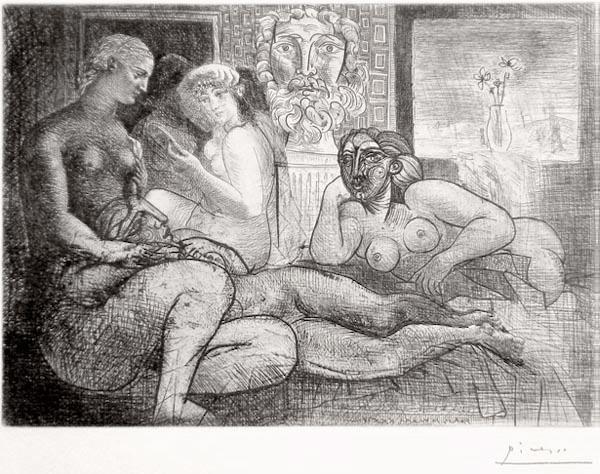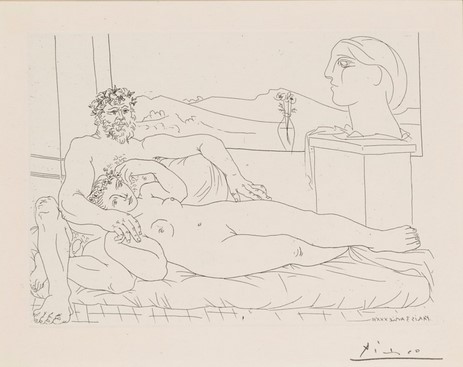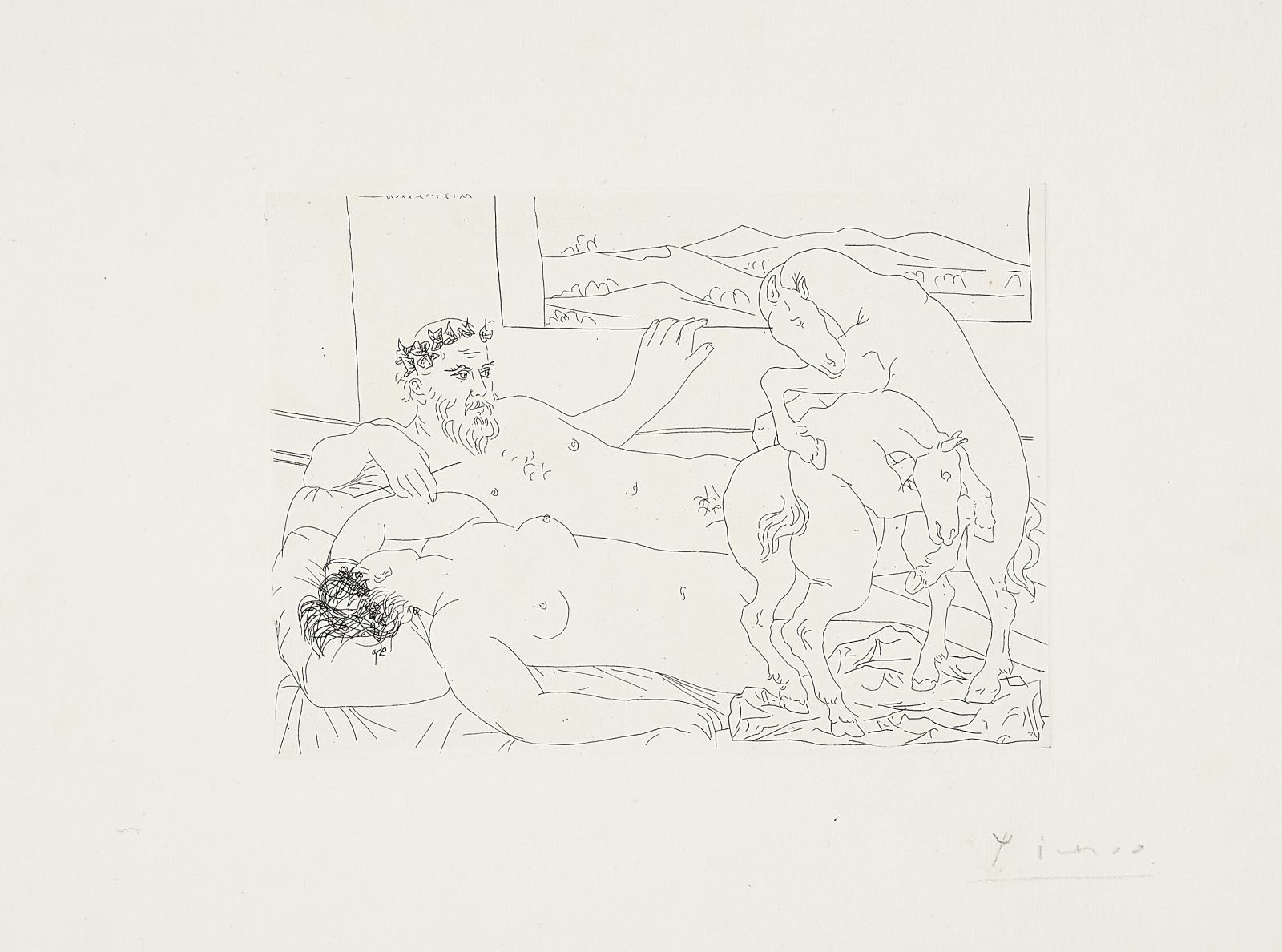GALLERY JEANNE
original fine art prints & paperworks of the 20th century and contemporary artPABLO PICASSO (1881-1973)

Pablo Picasso
‘Quatre femmes nues et tete sculptée’
La Suite Vollard (page 219)
1933
Etching on Montval paper
Edition 245+ 15 AP
33.7x44.5cm
signed

Pablo Picasso
‘Le Repos du sculpteur II’
La Suite Vollard (page 1)
1933
Etching on Montval handmade paper
Edition 245+ 15 AP
33.7x44.5cm
signed
Bloch 172

Pablo Picasso
‘Sculpteur and son of model devant une fênetre’
La Suite Vollard (page 168)
1933
Etching on Montval
Edition 245+ 15 AP
33.7x44.5cm
signed

Pablo Picasso
Colombe flounce’
Lithograph on Arches
Handmade paper
1952
21.5″ x 30″
Edition 200
signed and numbered
Bloch 712
SOLD

PABLO PICASSO
‘Vieux sculpteur with woman, cheval luttant’
La Suite Vollard (page 173)
1933
Etching on Montval handmade paper
Edition 245 + 15 AP
33.7 x 44.5 cm
signed
SOLD
PABLO PICASSO (1881-1973)
ARTIST INFOPablo Ruiz Picasso (1881 Spain – 1973 France)
The Spanish painter, sculptor and graphic artist Pablo Picasso left behind a comprehensive oeuvre of drawings, graphics, collages, paintings, ceramics and sculptures. Picasso’s best-known works include the paintings “Demoiselles d’Avignon” (1907) and “Guernica” (1937) – as key works of Classical Modernism – as an artistic exploration of the Spanish Civil War.
Picasso was born in Malaga in 1881. In 1895 the family moved to Barcelona. At the age of 14 he passed the admission to the art academy “La Llotja” and was allowed to skip two classes. After only a year he moved into a joint studio with Manuel Pallarès.
In 1897 Picasso went to Madrid to study at the “Royal Academy of San Fernando”.
Since 1897/98 he signed instead of RUIZ for the first time with “P. Picasso”
The Prado and the artist’s bars in the capital became his school.
In 1900 Picasso had his first exhibition entitled “Els Quatre Gats”. In the same year he traveled with Casagemas to the world exhibition in Paris, where the works of Edgar Degas, Paul Cézanne, and Pierre Bonnard could be seen. From then on, the artist shared a studio with Casagemas here – in Montmatre, 49 Rue Gabrielle. City life and the works of Toulouse-Lautrec influenced his work during this period.
Back in Madrid, Picasso published the art magazine “Arte Joven” as an illustrator together with the writer Francisco de Assis Soler.
When he returned to Paris, he found his first art dealer in Pere Manach and his first gallery owner in Berthe. The publisher Amboise Vollard is showing his works for the first time in an exhibition – the pink and blue periods are on display.
In 1910, Picasso painted his patron Vollard in a well-known Cubist painting.
Picasso’s artistic career began with works from the “Blue Period” (1901–1904) and the “Pink Period”. Picasso founded Cubism together with the artist Georges Braque (1908-1914). The “analytical phase” of Cubism lasted until around 1912 (portrait of Vollard – 1910) and then passed into Picasso’s “Synthetic Cubism”. The “Papiers collés” were created in the transitional phase (from 1912).
Picasso exhibited in 1910 at the “Neue Künstlervereinigung München”, at Herwarth Walden’s gallery “Der Sturm” in Berlin and in 1912 at the Sonderbund in the city of Cologne. At the same time, 4 works by Picasso can be found in the Blue Rider/Blaue Reiter exhibition in Munich. And in London he took part in the show “Manet and the Post-Impressionists” with drawings, paintings and prints (1910 and 1912).
1923 Picasso meets André Breton and surrealism (1924–1936)
Between 1930 and 1937 the “Suite Vollard” was created – a series of 100 graphics
… including the Minotaur motif and the artist and model theme. Since 2001 a complete series can be found in the “Pablo Picasso Graphics Museum” in Münster.
The theme of the bullfight combined with the Minotaur myth pervades Picasso’s entire work. In his “Minotauromachy” Picasso quotes Francisco de Goya. The “La Tauromaquia” series from 1957 contains 26 aquatint etchings that serve as illustrations for the bullfighting textbook.
In 1949 he made lithographs again, whereby Picasso revisited a technique from his artist years from 1919-1930.
For example, “Les deux femmes nues” or “Tête de femme” emerged.
By the way, in 1949 Picasso designed the dove motif as a peace symbol for the World Peace Congress in Paris – which is still used internationally today …
In 1968 Picasso devoted himself to different series of etchings:
- “Painter and Model”
- and “The Reclining”
- as well as etchings on the subjects of bullfighting, circus
- and equally erotic works
- …
Picasso’s work can be found in well-known museums and collections around the world:
- Picasso Museum, Paris
- Lille Métropole Museum of Modern Art
- Pushkin Museum, Moscow
- Hermitage, Stankt Petersburg
- Museo Reina Sofia, Madrid
- Museum of Modern Art, New York
- Art Institute of Chicago
- Museo Picasso, Málaga
Two museums were dedicated to Picasso’s artistic genius during his lifetime:
- Museu Picasso, Barcelona
- Picasso Museum, Antibes
You are welcome to contact us if you are looking for or want to purchase works of art by the artist Pablo Picasso.
For further positions by Pablo Picasso in the Galerie Jeanne
– “Graphics & Paper Works of the 20th Century and Contemporary Art” in downtown Munich –
you can contact the gallery owner Jacqueline Hoffman via WhatsApp or by phone directly at
Adress: GALERIE JEANNE – Graphik & Dessins, Prannerstrasse 5 (back side: Hotel Bayerischer Hof), 80333 Munich – GERMANY

